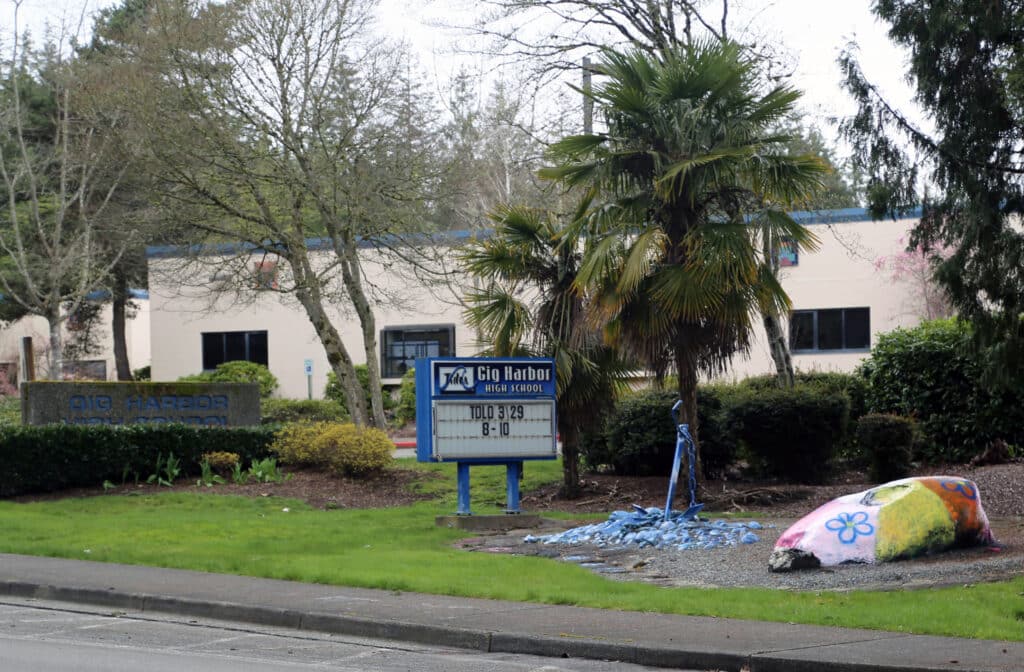Community Education
Peninsula School District committee says high schools should be “highest priority” to upgrade
Peninsula School District’s Long-range Facility Advisory Committee reported to the school board last week that both Peninsula High School and Gig Harbor High School “should be the highest priority for large-scale maintenance, repair or replacement.”
The report evaluates the condition and functionality of all school buildings and support facilities, like the bus barn, which the committee said requires “urgent attention at the earliest opportunity.”
The committee also found that two of the 10 elementary schools, Minter Creek and Discovery, are well past their useful life based on state school building standards. It said both schools (as buildings go) “underperform in both functionality and support for educational programing.”
The committee was impressed, however, by how well staff throughout the district provide “excellent education” to students regardless of building conditions.

Gig Harbor High School. Photo by Vince Dice
Committee’s scope of work
The eight-person Long-range Facility Advisory Committee, formed in March 2024, includes parents, community members and staff. The district invited everyone who submitted an application to serve. Ross Filkins, Peninsula High School’s athletic director, and Bryan Bullock, a teacher and drama director at PHS, are the only staff members on the committee.
The committee was asked to evaluate all district buildings, focusing on safety, functionality and overall condition. They visited almost every site, except three of the four newest elementary schools built with the district’s 2019 bond.
The committee considered how each facility stacked up against state school building condition standards in a report prepared by the district in 2019. They also created an “assessment worksheet” for each building, said committee Chairman Ben Patinkin, a parent of students in the district.
Schools’ capacity
The committee evaluated capacity data supplied by the district. Elementary schools had the most available capacity, not surprising since the 2019 bond targeted growing enrollment at the elementary level. Elementary enrollment is leveling out and is projected to stagnate in the near future.
Middle schools had the next greatest capacity, according to the report.
The district’s three high schools had the least capacity. Peninsula, Gig Harbor and Henderson Bay high schools have a current head count of 2,840 students and “ideal” combined capacity for just 2,941 — only 81 more.
District’s newest buildings
The committee assigned schools and other facilities to one of five tiers, based on the assessed urgency of need for major renovation or replacement.
Tier 5 buildings are in good shape, requiring only preventive maintenance. This group includes all schools renovated, replaced or built with the 2019 bond. Voters approved $198.5 million for the four elementary schools: Pioneer, Artondale, Evergreen and Swift Water (all completed in 2021). Bond funding also covered major renovations of Key Peninsula Middle School (2024) and Kopachuck Middle School (2023).
The district’s Community Transitions Program, supporting young adults up to age 21 in need of life-skills training, is located in an office building on Soundview Drive and was designated as a Tier 5 facility.
Tier 4 buildings, all built or modernized within the last 20 to 25 years, include Purdy Elementary (2005), Harbor Ridge Middle School (2002) and Henderson Bay High School (2002). They “provide adequate function and support for education programs and don’t need an upgrade at this time,” the committee said.
At or past their useful life
Tier 3 and 2 schools are near or past the end of their useful life, based on state school building standards, according to the report.
Tier 3 schools, in most cases, don’t meet current building standards due to changing guidelines since construction. They all need major repairs such as roofs, HVAC, siding or fixtures. “Classroom layout can be quirky depending on the year built,” the report states. Kitchens tend to be too small, and the buildings can’t support technology infrastructure like newer schools.
Tier 3 schools include Vaughn (1992), Voyager (1988) and Harbor Heights (1991) elementary schools, and Goodman Middle School (1991).

A well-known landmark on the Peninsula High School campus.
Facilities falling short
Two elementary schools, Minter Creek (1981) and Discovery (1980), have both exceeded their lifespan by state standards and were designated Tier 2 facilities. “These facilities lack modern building features like secure vestibules, permanent classroom walls and limited exterior access points,” the committee said. Technology is a challenge and so is access to up-to-date bathrooms.
Most in need of TLC
More than half of the district’s buildings and facilities were built or renovated more than 20 years ago. Some date back decades.
Parts of Peninsula High School are from 1946. That school had an upgrade in 2004. Gig Harbor High, built in 1978, last had a major renovation in 1991. Both are designated Tier 1 buildings.
“These are the schools that are most in need of tender loving care,” Patinkin said.
Stand-out problems with both schools include:
- Lack of secure vestibules and limited exterior access points
- Problems with handicapped accessibility
- Some classrooms too small
- Limited access to technology infrastructure
- Limited number of bathrooms compared to Tier 5 schools
Robust programming ‘hamstrung’
A big problem with GHHS is the lack of natural light, the committee found. On a tour, the principal said the school is “lovingly referred to as a prison because you walk in there and there is no daylight,” according to Patinkin. During an extended power outage earlier this year, students had to navigate the halls using their cell phone flashlights.
“In both schools, access to robust, modern electives is hamstrung, relying on antiquated equipment, classrooms etc.,” the committee said. “Sports facilities and gyms are aging and offer inadequate space for current athletic programming.”
The district’s bus barn and associated facilities, built in 1970, are also designated Tier 1. These buildings, with the high schools, “require urgent attention at the earliest opportunity,” the committee recommended.
Sports fields and playgrounds
The district’s play fields and playgrounds need attention, as well, the committee said. Sports fields serve not only students but also community youth and athletic programs.
“We find that most of our outdoor facilities are challenged to meet existing demand,” the report said. “As an example, some high school sports teams currently travel off campus to outside facilities for practice or home games.”
Athletic facilities lack capacity for the area’s growing population, the committee reported. “For example, the 2024 Fish Bowl (football game) had to be moved to Mt. Tahoma High School due to Roy Anderson’s (field at PHS) inability to accommodate community attendance,” the report said.
Turf field planned at GHHS
The committee gave the district kudos for work on outdoor facilities that is underway or planned.
Harbor Heights this summer is getting an inclusive play structure accessible to all students, including those in wheelchairs. This is the second phase of inclusive upgrades, designed with input from the Special Education Parent Advisory Committee. Purdy Elementary is getting a new, modern play toy with rubber surfacing on the main field.
The district next spring will install turf and resurface the track at the lower field at Gig Harbor High School, among other upgrades. The project, paid for from the district’s capital facilities fund, is now in the permitting process, Patrick Gillespie, director of grounds and maintenance, reported at the May 20 school board meeting. Construction is likely to run from April or May through September 2026, Gillespie said.
The field upgrade will ease scheduling at Roy Anderson Field for JV, C-team and some varsity team games, the committee noted. Proposed lighting will expand access to the field for sports teams and groups like marching bands or NJROTC, Patinkin said.
Teeing up for a bond?
The committee’s report sets the stage for the possibility of a bond or other capital measure, but Patinkin deferred to the school board when asked about any recommended “next steps.”
“Our understanding of our role was to take a 30,000-foot look at all of the different items we discussed at the beginning of the presentation,” Patinkin said. “And then sort of rank order the urgency of need around addressing our concerns for each of these facilities.”
Tier 1 buildings, including the two large high schools, the bus barn and associated facilities, ranked most urgent, according to the committee’s research, Patinkin said. “So, Tier 1 is definitely the highest level of need. How you as a board and the district want to approach those, Tier 1, Tier 2, Tier 3 schools moving forward, is why you are earning the big bucks.”
If the district were to consider a bond or capital levy, the school board would have to vote on putting a proposed measure before voters. School board members are non-salaried elected officials. Other than travel reimbursements, they receive no money for their service.
The district’s most recent capital measure was a three-year Safety, Security and Technology Levy, approved by voters in 2023.

